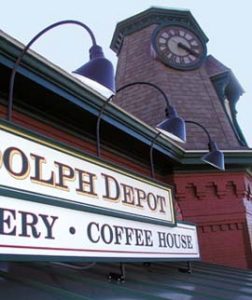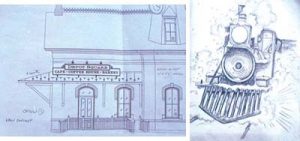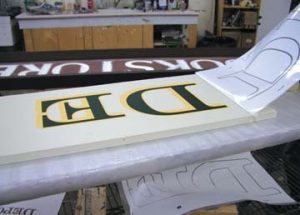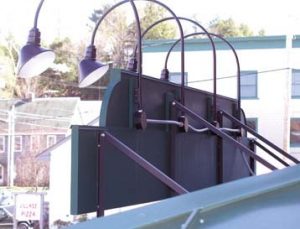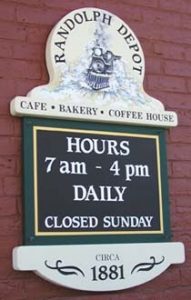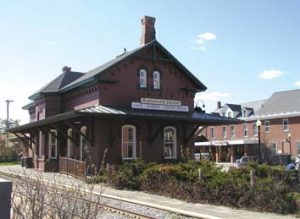Metal Fabrication
Trains of Thought
Wood & Wood Signs reinvigorates a former railroad depot.
Published
18 years agoon
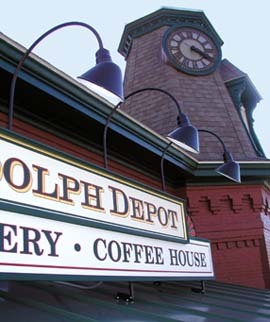
Historic preservation is a noble and valuable contribution for a signmaker to provide for any community. Wood & Wood Sign Systems Inc. collaborated with the owner and general contractor of a converted railroad depot in Randolph, VT, to design and fabricate a sign program. The structure is now the home of the Randolph Depot café and bakery.
The owner, Sam Sammis, offered helpful, historic photos of the depot. He also had an open mind regarding its design, and he gave us an open slate.
The right look
A railroad depot conjures many memories that stimulate graphic design. Photos provide clues into sign-fabrication methods. However, since the depot was built in 1890, many signs have adorned it. I suggested that we pick imagery and typography reminiscent of circa 1900 to 1925.
I mulled handcarved signs, cut-out letters, metal signs, electric signs, etc. But, the longer I looked at the building, I realized painted letters with classic framing best suited the project. The depot's location, 200 ft. from the road, necessitated large, readable and well-lit letters.
Because painted letters don't cast shadows, you can implement virtually unlimited colors, drop shadows and outlines to make them visually enticing. So, while extolling outlines and drop shadows to Sam, we investigated town sign regulations regarding square footage and location. Happily, Randolph's permissive sign code allows roof signs, which were very prevalent in the early 1900s because they elevated copy for viewing from a distance. With this in mind, we promptly developed a plan.
AdvertisementOn paper
For staff and client approval, I referred to our site photos and created pencil tracings of varied elevations and perspectives. We developed a sign system that comprises two rooftop signs with accenting, gooseneck lights; one doorway sign; one entrance sign and one street-address sign. From the rough sketches, we developed accurate, computer-rendered elevation drawings and scale, color drawings of each sign.
At this stage, we began the font-selection process. We only considered early 1900s representatives, such as Caslon, Clarendon and Bodoni. Further, we sought fonts that denote a railroad station and were legible from a distance.
We sent them to Sam, with our comments, and asked him to select two or three fonts for the various sign types. We mutually agreed on Century Schoolbook Bold, because of its wide letters and kerning, and its thickness, which allows more drop shadows.
Getting graphic
I also share graphics or art I'm considering with the client. Sam liked the idea of a train approaching a depot. Having been a history major at St. Lawrence University, I felt like a kid in a candy store. I discovered several appropriate early-1900s locomotives, and the one that we all liked was a train approaching during a nighttime snowstorm. To prevent overexposing the image, we reserved it for the café's eye-level, front-door signs and interior menuboards.
AdvertisementAfter scale-drawing approval, we began devising actual-size, paper layouts of the copy and graphics. This aids layouts, scale judgements and color tests. One of the main, roof-sign samples required complicated letter layering with a drop shadow and dual outlines. These letters had to sing loudly at a distance.
For greater weatherability and longevity issues — and because vinyl wouldn't stick to the outline's slender surface — we opted to use Benjamin Moore and Sherwin Williams flat, matte, latex paints. We output the transmasks using our Gerber enVision 375 plotter. This was time consuming, because each layer required two to three paint coats, with four separate layers for each letter. Because of the four to six hours of drying time required between coats, the sample board required four days to fabricate.
Let it snow
The train art for the entry sign and menuboard headers also required approval. Painting a bright-white, snowy scene on a light-beige background was daunting. The client chose beige because it contrasted well with the building's deep red. However, a few hours of painting contrasting blues and grays into the snow were required to convey a distant locomotive plowing through the snow.
Let there be light
The last exterior-sign challenge involved developing appropriate lighting for the two roof signs. In order to create effective and aesthetically appropriate lighting, we chose Spero Lighting (Streetsboro, OH) emblem reflectors. This product's screw-in socket allows multiple bulb choices — incandescent, halogen and fluorescent.
AdvertisementNext, Wood & Wood designed custom, gooseneck arms, which we attached behind the roof signs. To achieve critical wind-load support, we attached them in two places (one for each conduit) on the back of each sign so that we could run the wiring to feed one point to a power source.
Final details having been approved, we began fabrication. We continued our process of conceptual design, scale drawing, full-size patterns and color samples — with approvals at every step — to ensure historically accurate signage.
The rooftop signage comprises Signal® MDO boards, which we readied with a primer coat and epoxy to seal the edges. To achieve the desired, 3/4-in. thickness, we laminated three pieces of Signal board together with epoxy and stainless-steel screws. Handcarved Sign•Foam® high-density urethane provided accents that were adhered to the roof sign with Hipur Former, a polyurethane, hot-melt adhesive.
The restaurant's initial name changed three times, but consistent design gave everyone confidence. Because we'd constructed full-size samples, fabrication posed fewer challenges.
We encouraged the clients to visit our shop during key fabrication points. The restaurant's chef and owning partner, Bob Hildebrand, helped us fine-tune the colors, the drip-edge details, roof attachments, setbacks that affix the building to the rooftop, and lighting.
The day the signs were installed, Sam praised our conceptualizing, drawing and implementation.
And, I think the building was happy with the process as well.
More on Wood & Wood
Sparky Potter, the proprietor of Wood & Wood Sign Systems Inc. (Waitsfield, VT), has run the 10-employee company with his wife, Peggy, since 1972. Wood & Wood has designed and fabricated signs, 3-D artwork, display systems, menuboards, storefronts and interiors, murals and custom light fixtures.
Recently, Moonlight Basin Resort (Big Sky, MT) enlisted him as lead designer for conceptualizing the branding of the New West Frontier — which Montana's many mining ghost towns inspired — into all aspects of the interior/exterior resort signage.
Equipment and Materials
Adhesive: West System Epoxy, from Gougeon Brothers, (989) 684-7286; polyurethane hot-melt adhesive, Hipur Former, from Franklin Intl. (Columbus, OH), (614) 443-0241 or www.titebond.com.
Brushes: Three-in., Ultra/Pro Firm brushes, from The Wooster Brush Co. (Wooster, OH), (800) 392-7246 or www.woosterbrush.com.
Gilding: Slow and quick sizes, from 1Shot LLC (Gary, IN), (219) 949-1684 or www.1shot.com; 23k surface goldleaf, from Art Essentials of New York (Airmont, NY), (845) 368-1100 or www.artessentialsofnewyork.com.
Lighting: Emblem sign reflectors, from Spero Electric Corp. (Streetsboro, OH), (877) 477-7376 or www.sperolighting.com; wrought-iron, gooseneck attachments and roof brackets fabricated by Mountainview Industry (Waitsfield, VT), (802) 496-2426. All wrought-iron attachments powder coated by Vermont Ware (St. George, VT), (802) 482-4426.
Paint: Exterior-grade, matte, latex paint from Benjamin Moore (Montvale, NJ), (800) 344-0400 or www.benjaminmoore.com, and Sherwin Williams (Cleveland), www.sherwin-williams.com; Zar® exterior, wood stain, from United Gilsonite Laboratories, (Scranton, PA), (570) 344-1202 or www.ugl.com.
Plotter: Gerber G-15 cutting plotter, from Gerber Scientific Products (South Windsor, CT), (800) 222-7446 or www.gspinc.com. Gerber Scientific Products
Software: Gerber Omega, from Gerber Scientific Products; Adobe Illustrator 8, from Adobe Inc. (San Jose, CA), (408) 536-6000 or www.adobe.com.
Substrate: Signal® MDO board, from Olympic Panel Products (Shelton, WA), www.olypanel.com, and bought from Saxonville (Concord, NH), (800) 367-1218 or www.saxonville.com; Sign•Foam® 15-lb., high-density urethane, from Sign Arts Products Corp., (Dana Point, CA), (800) 338-4030 or www.signfoam.com Sign Arts Products
Tools: Jigsaw from DeWalt Inc. (Baltimore), (800) 433-9258.
SPONSORED VIDEO
Introducing the Sign Industry Podcast
The Sign Industry Podcast is a platform for every sign person out there — from the old-timers who bent neon and hand-lettered boats to those venturing into new technologies — we want to get their stories out for everyone to hear. Come join us and listen to stories, learn tricks or techniques, and get insights of what’s to come. We are the world’s second oldest profession. The folks who started the world’s oldest profession needed a sign.
You may like
Advertisement
Subscribe

Magazine
Get the most important news
and business ideas from Signsofthetimes Magazine.
Advertisement
Most Popular
-

 Photo Gallery2 weeks ago
Photo Gallery2 weeks ago30 Snapshots of the 2024 ISA Sign Expo
-

 Paula Fargo2 weeks ago
Paula Fargo2 weeks ago5 Reasons to Sell a Sign Company Plus 6 Options
-

 Real Deal1 week ago
Real Deal1 week agoA Woman Sign Company Owner Confronts a Sexist Wholesaler
-

 Photo Gallery2 weeks ago
Photo Gallery2 weeks ago21 Larry Albright Plasma Globes, Crackle Tubes and More
-

 Projects1 week ago
Projects1 week agoGraphics Turn an Eyesore Cooler Into a Showpiece Promo in Historic Plaza
-

 Women in Signs2 weeks ago
Women in Signs2 weeks ago2024 Women in Signs: Alicia Brothers
-

 Signs of the Times2 weeks ago
Signs of the Times2 weeks agoJuly 1919 Signs of the Times Cover Features Woman Installer
-

 Business Management7 days ago
Business Management7 days ago3 Things Print Pros Must Do to Build Stronger Relationships in the Interiors Market

